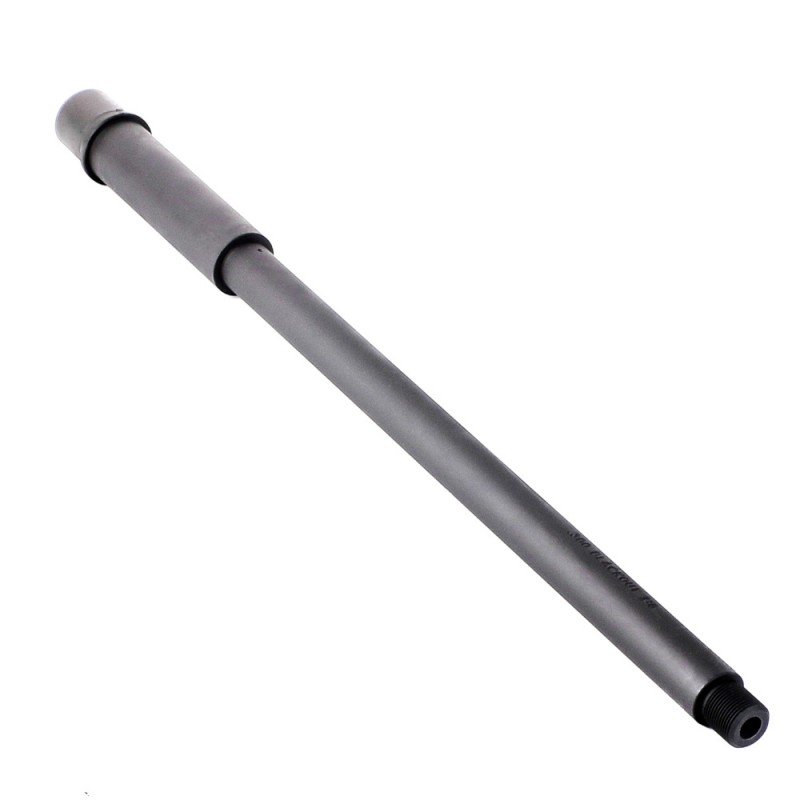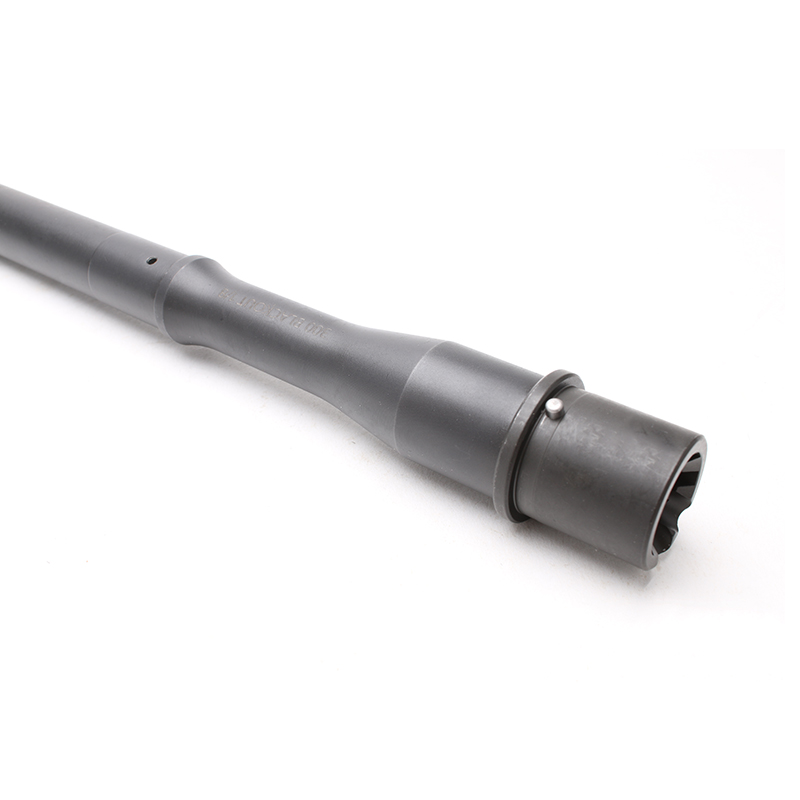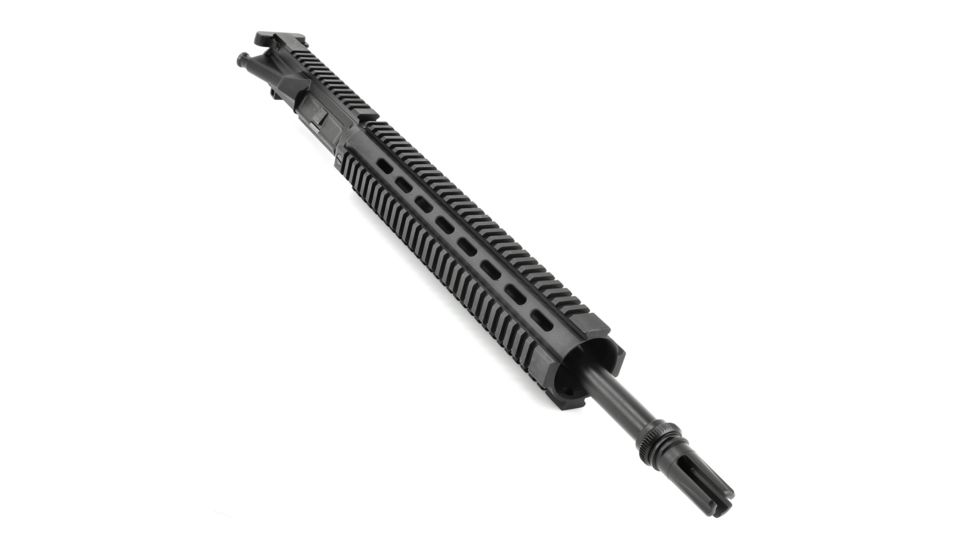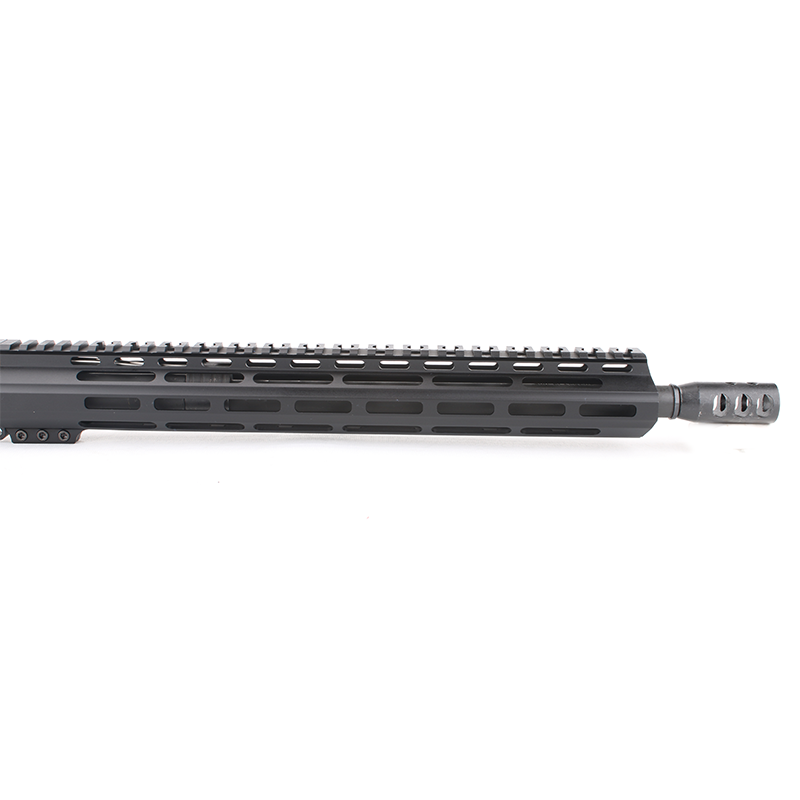This AR15 upper receiver assembly comes ready to attach to any Mil-Spec lower receiver. It is built around a 16 inch, 4150 chrome moly barrel that is chambered in 300 Blackout and has a black nitride finish. The upper receiver is a forged M4 flat top upper, allowing you to easily attach rifle scopes and red dot sights to the picatinny rail. This upper features our most popular rail, our seven-sided second generation keymod. So here's a rough rule of thumb for 300 Blackout guns. If your gun has a 16-inch barrel, a carbine length gas system should work just fine with supersonic and subsonic loads – especially if you use a silencer.
Some rifle makers, like Noveske, use pistol length gas systems in their 16-inch barrels, which other makes use carbine length. If you are going to buy or build a short length barrel gun, less than 16 inches, do yourself a favor and choose a pistol length gas system. The most reliable setup is going to be the pistol length gas system whether shooting subsonics or supersonics. A carbine length gas system does not require an adjustable gas block and requires no adjustment if shooting supersonics.
You can use a standard gas block which is a little cheaper than and adjustable one. But with a carbine length gas system you may run into problems cycling if you are not shooting supersonic, full power loads. Now if you are going to be adding a suppressor then the cycling issues go away in most cases. With 300 Blackout and its subsonic capability, people like to do cool things like use shorter barrels, say significantly less than 16 inches. The bullet is gone just as things start to operate and pressure drops too soon.
Here's the value of a pistol length gas system. With the port closer to the chamber, there's a longer period of awesome pressure time between the time the gas reaches the port and the bullet leaves the barrel. Lotsa gas and plenty of time means reliable operation of the action. There are powders which will make a carbine gas run subsonic on shorter barrels.
We tried down to 12.5 inches and it was cycling at 700 rpm with an H2 buffer. For a 16 inch barrel, carbine gas was a no-brainer as the gas port is not near max size, and we have an H2 buffer, and it is running at 750 rpm. If you like mid-length gas in 5.56mm, then a carbine gas for a 16 inch has the same advantages - less gas port erosion and more delay in unlocked the bolt. I have never seen, nor heard of a mid length 300 blackout barrel. The blackout is optimized with a pistol or carbine gas port.
Some 16" barrels with a carbine gas port will not cycle subs reliably, others will work fine. With pistol gas, both subs and supersonics should cycle fine with or without a suppressor. On a 16 inch barrel, pistol length gas will probably work with a normal size gas port, due to more time for gas pressure to build forward and rear of the port. On a 7 inch, or 10 inch, it WILL work, but may require tuning. Normally they don't work so well with heavier springs and buffers, with a standard size port. Already own an AR-15 chambered in 5.56 or .223?
You can swap your complete upper assembly for one chambered in 300 BLK and hit the range! Your existing lower receiver and buffer assembly, bolt carrier group, and even your standard magazines are compatible with 300 BLK cartridges, no modification required. 2 with carbine length gas systems (16" barrel) and one with a pistol length (10.5" barrel). I run a carbine buffer in both carbine length guns and they cycle supersonic rounds nicely but will only cycle subsonics with suppressor.
The pistol length will cycle both with or without the suppressor but supersonic ammo and the suppressor beats the the gun pretty hard. The shorter the gas system, the more reliably your sub gun will cycle suppressed, subsonic 300 BLK loads. I tried rifle length gas on a 20 inch barrel, and it did not work, even supersonic with a suppressor and a carbine buffer and with the gas port at 0.125.
I built a 16 inch barrel with a mid length gas tube and matched it up to an A2 buffer system, looks awesome but am having troubles with it. It will fire 1-2 rounds then jam ,Failure to close bolt fully. There is a round in the chamber but its like he timing is off.
So in the end if you plan on shooting subsonics you want to have a pistol length gas system. If all you are going to be shooting is supersonics then a carbine length gas system is going to work fine. But a pistol length gas system will work with both but might require an adjustable gas block. You should be running an adjustable gas block anyways to tune the gun for reduced recoil, reliability as well as to keep it cleaner for longer. Using an adjustable gas block you can artificially lengthen a pistol length gas system but there is no way to artificially shorten a carbine gas system.
In a standard 5.56mm AR-15, cartridges perform within a relatively narrow band of performance. As a result, gas pressure performance is somewhat predictable and rifle makers can design gas ports to operate reliably. With the 300 Blackout, and its huge range of ballistic options, finding a gas system design that works with supersonic loads and bunny fart subsonic loads can be a real challenge. If too much gas is allowed, the supersonic rounds can create excessive wear and tear on the rifle. Too little and subsonic rounds may not generate enough gas to reliably cycle the action. With 300 AAC Blackout gun design, there's a constant tradeoff between reliability and gas pressure.
Start doing things like changing the barrel length and things get even crazier. I ordered the 16″ blackout with 13″ CBC Gen 2 rail, it arrived withing 10 business days of ordering. Fit an finish is really good; the receiver itself It is indistinguishable from my BCM upper aside from the BCM logo. The handrail is light but very solid; I placed a bipod at the end of the rail and didn't notice any flexing.
I haven't removed the rail to inspect the barrel nut but everything seems to be aligned and installed correctly. Finish on the barrel is even; a little glossier than I expected but my other AR's are all parkerized, so I'm used to a very flat finish. On the range, it functioned flawlessly with my DD built lower and LMT bolt carrier group. Using Remington 120gr supper sonic ammo I was able to achieve 1.25 MOA groups.
This was shooting prone without a good rest so I'd imagine with a better rest and ammo groups will tighten up even further. If you part them out it will cost more to build yourself. Get it built and it will be tuned perfect with the hand guard of your choice, proper gas system, optional bolt carrier, and charging handle. Spikes also does a great job with complete uppers or parts. He's just saying it wont lock back not that he needs to do anything with the bolt carrier. Definitely sounds like a buffer issue with a carbine gas system and a 20 inch barrel.
Guess he didn't know that on the 20 inch barrel he needs a mid length or rifle gas system. Or replace the buffer on the 20 inch but due to the carbine length it will probably where extremely fast. If you are looking for a short pistol length barrel for your .300 Blackout AR-15, you'll want to take a close look at the Palmetto State Armory 10.5" CHF .300 Blackout pistol gas barrel. This barrel is hammer forged out of chrome moly vanadium steel and is also chrome lined on the inside of the barrel in order to extend its overall service life. The chrome lined barrel is considered to be military standard for this same reason. My first 300Blk build was a rifle with mid length gas system and standard rifle buffer.
I had a problem with 150 grain bullets, but solved that by enlarging the gas vent hole in the 18 inch barrel. Subsonic bullets convert it into a straight pull bolt action, although it has enough umph to eject the spent case, just not load a fresh round. It never had any problems with 125 or 130 grain bullets.
The rail also features a full-length picatinny top rail that sits flush with the upper receiver and has anti-rotation tabs to keep it locked in place. This upper assembly comes with a standard A2 flash hider that effectively suppresses muzzle flash and protects the 5/8×24 barrel threads if you are planning on adding a muzzle break in the future. If you are looking to be flexible between super and subsonic loads please understand there are tradeoffs to be made. You will need to set your gun up the same way as if you were only going to shoot subsonic loads. As long as you ensure your gun functions with the weakest ammo you will be shooting, you can then just load a magazine of the supersonic rounds and the gun will cycle. The tradeoff being made is the gun will be a bit overgassed and run a bit harsh.
We would still recommend a shorter barrel in this setup no longer than 11", however that is not to say you could not run a 16" barrel. Just understand the limitations of that barrel and gas system as described above. Make certain your bolt catch, bolt catch plunger and bolt catch spring are properly installed. You should have already cleared the rifle chamber.
Insert an empty mag with the bolt carrier closed then cycle the BCG with the charging handle. The bolt carrier should have been stopped, chamber open. First, the mag has a problem with the mag cartridge follower being worn or otherwise damaged or second as someone else said, the bolt catch could be damaged. I don't think that would be the case because the catch is made of pretty good steel. If the weapon is cycling fine, I would try a different mag because, with proper cycling during firing, I would doubt very much you have a buffer problem.
Since a subsonic 300 blackout round is heavy and uses less powder than supersonic rounds, it's crucial to utilize as much gas as possible to cycle the firearm. Lastly, this is a complete upper receiver, so it does include a charging handle and bolt carrier group. The S&W M&P Whisper is a simple system that's easy to suppress and rearing to go out of the box. The bolt was bent, upper receiver bulged out, barrel extension trashed, lower receiver trashed and the barrel was now plugged with one very elongated .308 caliber projectile.
The shooter was incredibly lucky as much of the pressure escaped through the magazine well. Still, there was enough force in the conflagration to bend a lot of steel and aluminum. The shooter suffered plenty of stinging and mild burns to his hands and face.
A 16 inch carbine gassed gun has barely enough juice to cycle the action. That's why they work best with a gasport that is opened as wide as the gas tube will allow (.120) and with a standard carbine buffer. The only issues I've had shooting my 300blk is with the sub rounds, so I save those for the bolt gun. 300blk will run fine in semi auto with supersonic ammo. I also run a carbine weight buffer and it's worked very well, in both my 16" Noveske and AAC 9" pistol. We believe carbine position is best for compatibility with Remington supersonic and subsonic ammo for a 16 inch barrel, and pistol position for shorter barrels.
On a longer barrel, the dwell time will be longer, because the bullet has to travel a longer distance. Specifically, there is a tiny amount of time when the bullet is traveling through the barrel and it is past the gas port, but it's still in the barrel. During this time, there is hot gas traveling through the gas tube into the receiver. As soon as the bullet leaves the muzzle, the gas stops flowing. Because of the rounds ballistic capabilities of moving below the speed of sound, there is an inherent problem with the amount of powder load used to propel the round.
Too much powder and the bullet will break the threshold of sound, defeating the cartridges purpose. When entering subsonic world you are going to be factoring in a suppressor, ammunition types, barrel sizes, gas systems, buffer tube weights. All of which can have an effect on how well your rifle performs. All in all, the Brownells .300 Blackout Barrel & Carbine Gas System kit is an excellent value that allows you to customize your existing gas system. The sixteen inch barrel will offer superior velocity to a pistol length barrel, and the 4150 steel construction and nitride finish means that it's ready to be used out on the field in poor conditions. A critical moment of dwell time is when the bullet has passed the gas port but has not yet left the barrel.
This is when the propellant gases enter the gas block and circulate into the gas tube. As soon as the bullet leaves the barrel, propellant gases stop flowing into the gas system. Once assembled (16″ barrel/carbine length gas system ) we test fired my Uncle's, and the round wouldn't properly eject. We swapped buffers and springs, BCG, and even hand loaded a variety of rounds…all with no success in ejection. Once we took the upper apart, found that the gas tube wasn't perfectly lined up with the gas block. Furthermore, the gas tube diameter was significantly larger than the gas block port.
Taking it a step further, the barrel gas port wasn't near the diameter of either of the aforementioned holes…leading to a significantly undergassed AR. I just got back from my indoor rang after firing retail and ammo I reloaded using Winchester 768 powder trickled to 15.5 grains and 150 gr. The American Eagle and reload ammo preformed indistinguishable and excellent. With a 3X scope shooting benched @ 25 yards the groupings were on top of each other cutting a big dot on the target. I gave it a 5 star because of the price and functionality. The hand guard is excellent and aligned perfectly and the upper is light and solid.
I bought this with the BCG and charging handle and the fit is perfect. The black finish doesn't seem as durable as my Sig .223 ($1,200) or DPMS .308 ($950) but still good. I bought a Anderson Lower ($136) and this upper ($349) with BCG and Charging handle for less than $500 there is no decision for me. I ordered this upper receiver and the bolt/charging handle and was pleasantly surprised that they placed the bolt and charging handle into the upper receiver before they shipped it to me. Everything looks straight and the quality for the priced is excellent. My upper rail and hand guard rail align pretty close so I am happy with the purchase.
BCM® has taken great care to ensure the best possible performance and interchangeability. However, due to the large operational range of 300 Blackout ammunition in the market place, BCM® cannot guarantee function will all ammunition types in all conditions. These barrels were designed to run with a carbine buffer with subsonic ammo and a H3 buffer with high velocity ammo. Fine tuning may be required in limited instances based on ammo and buffer choices that work best for the desired application.
BCM® also recommends running the Crane O-ring (provided with all BCM® Bolt Carrier Groups) over the extractor with 300 Blackout. If you use a pistol port gas on a 16 inch upper, with a large gas port in order for it to work with the faster powders, then it will cycle too fast with supersonic ammo, especially with a suppressor. Your buffer and spring work together, providing enough reciprocating energy to push the bolt carrier group back through the upper receiver, chambering another round and resetting the trigger and firing pin. If your bolt doesn't lock to the rear, or if you often get failures to feed, you may be suffering from a buffer that's just too heavy. Use the same gas system you have now or just re-place the gas block and tube that is required for your new barrel.
Your present BCG and CH will work just fine, no change there. The bullet weight for hunting will depend on what you're hunting, light bullets for small game and heavier for larger I think should be the way to go. You can even use your 5.65 barrel nut and handguard for the swap. The carbine and rifle bolt carriers are not the same.
























No comments:
Post a Comment
Note: Only a member of this blog may post a comment.